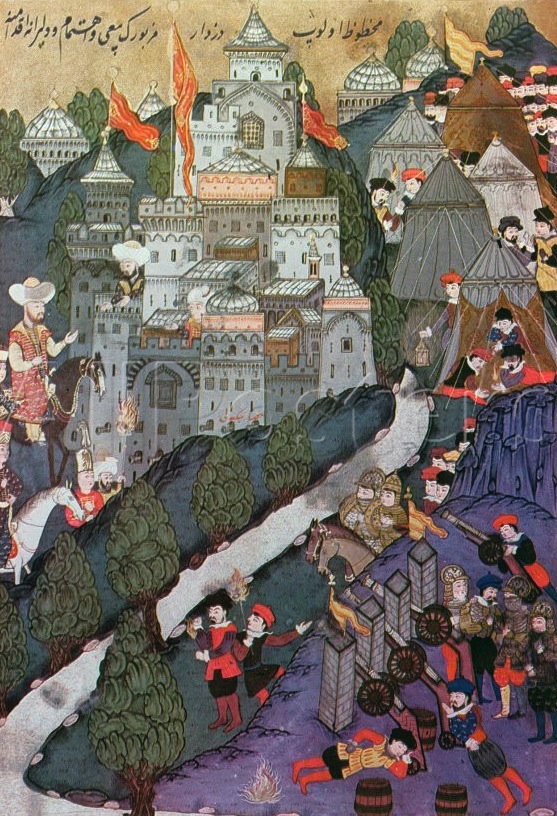Sultan Bayezid breaks the siege at Nicopolis and comes close at night to the besieged castle of Nicopolis and encouarages the castle commander Dogan Bey. Source: Hünername, Doğan Kardeş, İstanbul 1969
When Emperor Manuel II traveled to the West at the end of 1399 in search of financial and military help, the pressures and hardships induced by Bayezid’s protracted siege had become excessive in Constantinople. During the next few years conditions inside the city continued to deteriorate, leaving almost everyone from the common people to members of the highest levels of society impoverished and hopeless. Dilapidated or demolished houses, unattended monasteries and churches, uncultivated gardens, vineyards, and fields were spread throughout the depopulated city that was daily losing growing numbers of inhabitants to Italian or Ottoman territories. Furthermore, those who remained in the city not only had to struggle with starvation and exhausted revenues but also had to protect themselves from opportunistic people who engaged in profiteering. The latter, consisting of a small group of wealthy merchants and businessmen who managed to continue participating in long-distance trade despite the blockade, endured minimal losses in comparison with the rest of the population. Judging from the exorbitant prices they charged for products they brought into Constantinople, the high interest rates they demanded for loans they handed out, and the investments they made in the city’s real-estate market at prices well below actual values, they seem to have more than made up for whatever difficulties their trading ventures abroad might have sustained as a result of the siege.
If, on the other hand, Manuel II’s departure for Europe in 1399 had initially aroused among the citizens of Constantinople expectations of western help, hopes were most certainly dwindling a year or two later, as the Emperor continued his tour of European courts without having accomplished much that was deemed satisfactory. Consequently, diverse groups of people who could no longer tolerate being confined inside a city with the social and economic conditions outlined above began to agitate in favor of surrender to Bayezid’s forces. As early as about the time of Manuel’s departure, the common people had been contemplating surrender, hoping that they would thereby escape starvation and misery. During the years that followed, in addition to numerous citizens who fled from the capital and individually turned themselves in to the Ottoman soldiers standing guard outside the city walls, several embassies were dispatched to the Sultan to propose to him the delivery of Constantinople. Patriarch Matthew reports in an encyclical he composed in 1401 that on three occasions, “a short time ago,” ambassadors had been sent out of the city to negotiate with Bayezid. The patriarch claims that on each of these occasions he threatened the envoys with excommunication, lest they should attempt to betray the city to the enemy.
Shortly before the battle of Ankara (July 28, 1402) “the inhabitants of Constantinople” sent another embassy to Bayezid, selected from the city’s notables. This time, however, because the Ottoman ruler was distracted by the recent challenge of Timur, they expected to be able to secure some concessions from him. The ambassadors were to inform the Sultan that the Constantinopolitans were ready to obey all his orders in the capacity of his vassals only, “since it was not possible for them to betray the city voluntarily at any time.” But, adds the same source, Bayezid would not hear of such a bargain, and the embassy ended without even a simple achievement as, for instance, the grant of freedom to the inhabitants to leave Constantinople for a place of their own choice, should Bayezid happen to capture the city. What the anonymous Byzantine author reporting this event does not realize, or does not want to admit, however, is that under the precepts of Islamic law, a concession such as the one he mentions would normally be granted to the inhabitants of a city that surrendered, and not of one that was captured by force. Yet the Constantinopolitans at large seem to have been familiar with the Islamic practice since, following the failure of the above-mentioned embassy, “they were all ready to surrender themselves to the barbarians without battle after the victory [of Bayezid over Timur].” This statement is confirmed by a letter John VII wrote to King Henry IV of England scarcely two months before the battle of Ankara, in which he stressed that the Byzantine capital was on the verge of submitting to Bayezid’s men and urged the rulers of the Christian West to hurry to the city’s aid. According to the historian Kritoboulos, too, sometime before Bayezid’s encounter with Timur, an agreement had been reached between the Ottomans and “the citizens” of Constantinople, in which the latter promised to deliver themselves and their city to the Sultan on a specified day.
There is no evidence indicating to what degree, if at all, the Byzantine government was involved in the preceding arrangements which the sources vaguely attribute to the “citizens” or “inhabitants” of Constantinople. Yet, just on the eve of the battle of Ankara, John VII, perhaps pressured by the determined conduct of the citizen body, is said to have made an agreement with Bayezid, promising to surrender Constantinople to the Ottomans immediately after the Sultan’s anticipated victory over Timur. About the same time, with or without the Emperor’s knowledge or consent, a group of archontes from Constantinople set out for Kotyaeion (Kütahya), in order to deliver the keys of the city to the Sultan. Before they had a chance to complete their mission, however, the news was heard that Timur’s forces had defeated the Ottoman army near Ankara and taken Bayezid captive. Delighted at this unforeseen development, the archontes bearing the city keys returned home, and Constantinople was thus saved from falling into the hands of the Ottomans.
